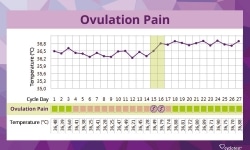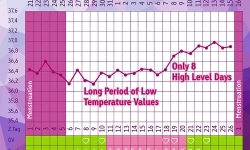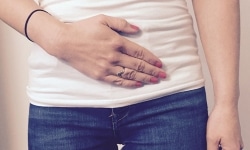Was Du auf dieser Seite findest:
What does Premenstrual Syndrome actually Mean?
PMS – everyone has probably heard the term before. What exactly is the nature of these symptoms? It was not until the beginning of the 20th century that the connection between the female hormonal balance and PMS was recognised. In 1931, Robert T. Frank identified premenstrual symptoms for the first time as a distinct clinical picture. It was described as a combination of physical and psychological symptoms.
Who doesn’t know these annoying days in the cycle. The lower abdomen aches and the breasts are tender. If only they could be erased. Have you ever wondered why they plague you so much? All these symptoms are summarized under menstrual symptoms. In addition to PMS (premenstrual syndrome), this also includes period pain, which we will discuss in another article. Here you can find out what the word premenstrual syndrome means, what its causes can be and what symptoms are associated with it.
Certain signs of PMS may also be confused with symptoms of early pregnancy.1 These first signs of pregnancy include breast tenderness. Have you already found out more about PMS? Then jump directly to our tips against PMS: What to do?
What Causes PMS?
To date, there are no precise results as to why women suffer from the annoying symptoms. However, it is suspected that the cause of this is the hormonal situation in the second half of the female cycle. As the release of estrogen ceases, the production of progesterone increases. Serotonin levels and endorphins in the body also decrease. Investigations indicate that an interplay between the vegetative nervous system, brain metabolism and the function of the ovaries triggers the symptoms. However, the exact metabolic factors are not yet known.2
Your lifestyle – diet, exercise, stress – might also determine the severity of the symptoms. These can be caused or at least favoured particularly by a lack of vitamins or by stress.1,3
Who Suffers from PMS?
It can be assumed that every second woman of mature age will notice changes in the second half of the month. These can be of varying intensity and physical or psychological nature. Women over the age of 35 are more likely to notice signs of PMS.1,3 Approximately 25 percent of those affected suffer from it. Around 5 percent feel strongly affected in their everyday lives.
The subspecies of PMS is premenstrual dysphoric disorder (PMDD/PMDS). With PMDD and PMDS, the complaints are particularly pronounced and everyday life can no longer take place in a regulated manner, both privately and professionally. Women suffering from this disorder must be able to be taken on sick leave in the period before their periods. This applies to about 5% of women of fertile age. Medical treatment is essential here.3
Symptoms of PMS
Since women are affected in different ways, we would like to clarify which symptoms can occur, as many people often do not even know that their suffering – such as headaches – can come from premenstrual syndrome. A distinction is made between physical and mental problems. These can occur either individually or together.
If you notice an aggravation of your symptoms or if you already have symptomatic pain in the first few weeks of your menstrual cycle, there may be more to it than “just PMS” and you should check with a gynaecologist during an examination.
Physical PMS Symptoms
Physical impairments include water retention in the tissue, which is also known as edema. These make the body appear “swollen”, which is why you feel thicker than at the beginning of the month. Breast tenderness can also occur. Touching becomes unpleasant.
In addition, many women feel very tired or upset, which is why they prefer to stay in bed all day long. Nausea, indigestion, circulatory problems, cramps in the lower abdomen, headache, migraine or back pain can also occur. Increased sensitivity to stimuli such as light, smell, noise or touch may also be noticed. In the PMS period, impure skin often appears.
The symptoms may also indicate a luteal phase defect. This disease is often responsible for the inability to conceive a child. A medical therapy and treatment of PMS is then recommended.
When do PMS symptoms Occur and for How Long?
The effects are particularly severe about five days after the progesterone level has reached its peak. This is 4 to 10 days before the onset of menstruation. With the onset of the menstrual period, the problems usually abate again as the progesterone level drops.
In the first 2 to 3 weeks of the menstrual cycle, most women feel comfortable with themselves, are positive and enjoy a high libido. PMS then manifests itself in the second half of the menstrual cycle.
The symptoms are signs of illnesses in individual cases. Typical lower abdominal pain could be endometriosis symptoms if they do not occur during the PMS period. In the case of such a condition, in which the lining of the uterus grows outside the womb, there are usually further symptoms such as very severe period pain or pain during sex. It could also be the onset of menopause or, in exceptional cases, thyroid disorder.3
Menstruation does not take place regularly in the period before menopause. This change also involves changes in the hormonal balance. Less oestrogen is produced and progesterone levels may drop. This can cause or worsen PMS-like symptoms. However, they may also be reduced or even prevented.3
PMS Before and During Menstruation
PMS occurs almost exclusively in cycles with ovulation. It is therefore counted as a physical ovulation symptom. Mental and physical problems usually begin up to 14 days before menstrual bleeding. As soon as the period bleeding starts, the symptoms usually subside again. However, it may also happen that they continue beyond this point.2
Duration of the PMS Phase
The duration of this phase varies from patient to patient. Symptoms may appear throughout the entire second phase of the cycle and may even worsen until the beginning of the bleeding. However, they can also occur on individual days or over a shorter period of time.
Using a smart cycle computer, you can easily evaluate your cycle and determine when your ovulation has taken place and when the postovulatory cycle time begins. Optionally cyclotest mywamySense can show you the PMS time. In this way you are warned, can take appropriate preventive measures in time and at least adjust your daily schedule a little bit to it. Observing the body’s symptoms also helps you to better understand the processes and identify possible irregularities or diseases.
Premenstrual Syndrome: What to do?
Unfortunately, there is no cure, but various measures can be used to alleviate the problem.
Medication & Co. for PMS?
There is weak evidence that a combination pill (containing the progestin drospirenone and the low-dose hormone estrogen) can help against PMS. Of course, a doctor should decide whether the use of these hormones makes sense after a thorough diagnosis. But like all medications and hormonal contraceptives, the pill or minipill also has side effects. And if pregnancy is desirable, this method is excluded anyway; therefore, natural remedies are a welcome alternative. In PMS therapy, a possible luteal phase defect should also always be examined, as this is often the basis of PMS, which often also manifests itself in pain and discomfort.
Monk’s pepper primarily breast tenderness and can have a positive effect on the cycle. It is one of the best-researched medicinal plants and has become firmly established in the treatment of PMS. A cup of ginger tea is very beneficial for headaches. Other medicinal plants for PMS treatment, which can usually be drunk as tea infusion, are lady’s mantle, yarrow, Mexican wild yam, lavender blossoms, valerian or hops. Women’s mantle tea in particular should have a noticeable soothing effect on PMS. In order for medicinal plants to develop their effects, they must be taken over a longer period of time. You must therefore have a little patience if you want to fight premenstrual syndrome gently and naturally.3
Nutrition & Co. for PMS
A bad mood before menstruation can be counteracted by the right diet. You should avoid salty foods or chocolate, as these products are not only bad for your health if consumed excessively, but also because they can encourage discomfort. Dairy products and red meat can also foster these symptoms. Special recipes for the nutrition when suffering from PMS with the optimal foods can contribute to the relief.
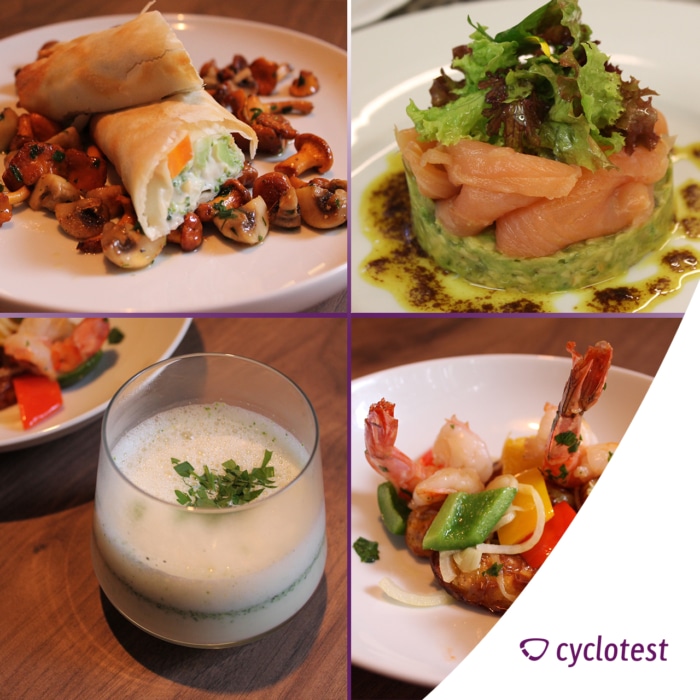
Die richtige Ernährung bei PMS | Foto: © cyclotest
Tips against PMS from Maggie
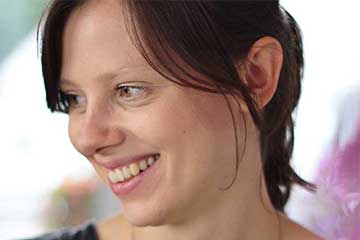
- Excercise: If you especially suffer from water retention – also a widespread symptom before the days – physical activity helps to remove the stored water faster. Sport also promotes blood circulation and can relieve cramps in the uterus.
- Relax: Those who don’t like to do sports can choose meditation and other relaxation exercises. For many people, however, relaxation also simply means lying down in the bathtub, listening to music, reading or watching a good movie.
- Eat healthy: Your body now needs many vitamins and minerals, so eat plenty of fruit and vegetables. Ideally, you should avoid (too much) alcohol, caffeine and sugar before your menstruation. Herbal teas can also be helpful, for example from lady’s mantle herbs, lemon balm leaves and chamomile.
- Supplement food: Unfortunately, there are no scientific studies that prove which dietary supplements actually help against premenstrual syndrome. Nevertheless, there has been a trend among women: Many people swear by magnesium, St. John’s Wort, yam, folic acid and monk’s pepper. Vitamin B6 and calcium may also help. It is best to consult your doctor or ask at the pharmacy.
- Sleep: Maybe you feel the same way as I do, and you sleep less well before your period. If possible, you should lie down again in the afternoon, even if it’s just to come down briefly and switch off.
Some women like to go in for moderate sports at this time. You could do yoga, for example, because it combines exercise and relaxation. This improves blood circulation in the body and combats the causes of abdominal cramps.
PMS can be a big challenge for a relationship. Some women feel their symptoms very strongly. As a man, it is certainly not easy to deal with it all the time. You could support your partner physically, mentally and emotionally. Help with household chores and other strenuous physical activities is certainly welcome. You could take over the cooking and pay special attention to antispasmodic foods and drinks. Listen to her, show consideration and be there for her. So you both get through this difficult period well.
PMS or Pregnant?
Some symptoms of the syndrome may also indicate early pregnancy. This includes pulling in the lower abdomen, cravings or mood swings. It can therefore happen that the signs of pregnancy are confused with those of premenstrual syndrome. Therefore, the question “PMS or pregnant?” is quite justified. However, only the (not) missing menstrual bleeding, a pregnancy test and/or a visit to the gynaecologist can provide clarity. Many women report that they had noticed pregnancy immediately and were able to distinguish them from PMS. However, this requires a great deal of familiarity with one’s own body and its signals in order to interpret them correctly.
Sources:
1 Kuhl, H. et al.: Sexualhormone und Psyche. Grundlagen, Symptomatik, Erkrankungen, Therapie. 1st edition. Stuttgart 2002.
2 Diedrich, K. et al.: Gynäkologie und Geburtshilfe. 2nd edition. Heidelberg 2007.
3 Flemmer, A.: Das Prämenstruelle Syndrom (PMS) natürlich behandeln. Hanover 2012.


